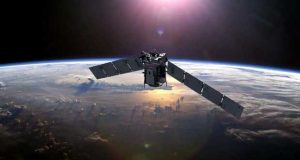
مریخنورد کنجکاوی به منطقهی مطالعاتی جدیدی خود رسیده است و مشغول بررسی سنگهایی است که قرار است چند هفته آینده را به مطالعه آنها بپردازد. کنجکاوی طی راهپیمایی ۳۰ متری خود در روز ۱۳ فروردین/۲ آوریل به بالای تپهای کوچک از منطقه اطراف خود که کیمبرلی نامگذاری شده است، عکسهایی را تهیه کرد.
ملیسا رایس، سرپرست تیم علمی کنجکاوی در انستیتوی فناوری کالیفرنیا/کلتک، در بیانیهای هدف از حرکت به سمت این نقطه مرتفع را به دست آوردن دید مناسب برای عکسبرداری از منطقهی کیمبرلی اعلام کرد. چهار گونه مختلف از صخرهها در منطقهی کیمبرلی یافت میشوند، که منبع غنی از مواد مطالعاتی را در اختیار کنجکاوی قرار میدهد. انتظار میرود با دسترسی به این مجموعه مواد، این مریخنورد به گستردهترین تحلیلهای خود پس از ترک منطقه یلونایفبِی در سال گذشته برسد. کنجکاوی در منطقه یلونایفبِی شواهدی از جریانها و دریاچهای باستانی یافت، که احتمال حضور حیات میکروبی در میلیاردها سال پیش در این نقطه را مطرح کرد.
{photo}93/01/20/mars{/photo}
فعالیتهای کنجکاوی در منطقهی کیمبرلی، توقفی موقتی در مسیر مریخنورد به سمت مقصد نهایی سفرش یعنی کوه شارپ است. کوهپایههای کوه شارپ تاریخ تغییرات محیطی مریخ در طول زمان را در دل خود دارد و کنجکاوی قرار است در حین بالا رفتن از این کوه این تاریخ را مانند کتابی ورق بزند و مطالعه کند.
کنجکاوی از زمان فرود روی سیارهی سرخ تا کنون، درون دهانهی برخوردی گیل ۶ کیلومتر راهپیمایی کرده است. اما تا رسیدن به کوه شارپ هنوز راه زیادی وجود دارد. از یلونایفبِی تا دامنهی کوه هنوز ۸ کیلومتر باقی مانده است که به گفتهی مقامات رسمی، کنجکاوی باید تا نیمهی سال جاری میلادی آن را طی کند.
منبع : space
NASA's Mars Rover Curiosity Arrives at Next Science Destination (Photos)
NASA's Mars rover Curiosity has reached its next study area and is now scoping out rocks that it will take an up-close look at over the next few weeks.
The Curiosity rover snapped new photos of Mars after driving 98 feet (30 meters) on Wednesday (April 2) and topping a small hill that affords a good view of the surrounding area, which NASA scientists have dubbed "the Kimberley," officials said.
"This is the spot on the map we've been headed for, on a little rise that gives us a great view for context imaging of the outcrops at the Kimberley," Melissa Rice of the California Institute of Technology in Pasadena, the science team lead for Curiosity's work at the site, said in a statement.
Four different types of rock intersect at the Kimberley, providing Curiosity with a wealth of material to study. The rover is expected to do a great deal of work at the site, conducting its most extensive analyses since leaving a spot called "Yellowknife Bay" last year, NASA officials said.
Curiosity found evidence of an ancient stream-and-lake system at Yellowknife Bay, suggesting that the area could have supported microbial life billions of years ago.
The activities at the Kimberley represent a pause in Curiosity's long drive to the towering Mount Sharp, which has been the rover's main science destination since before its November 2011 launch. Mount Sharp's foothills record a history of Mars' changing environmental conditions over time, and mission officials want Curiosity to read that history like a book as it climbs up through the mountain's lower reaches.
The Curiosity rover has now driven a total of 3.8 miles (6.1 kilometers) since touching down inside the Red Planet's huge Gale Crater in August 2012.
The rover has a ways to go yet before reaching Mount Sharp, however. The trek from Yellowknife Bay to the mountain's foothills will cover more than 5 miles (8 km); Curiosity should get there around the middle of this year, mission officials have said.
 گجت نیوز آخرین اخبار گجتی و فناوری های روز دنیا
گجت نیوز آخرین اخبار گجتی و فناوری های روز دنیا 





